Urban Forest Health Under Rapid Urbanization: Spatiotemporal Patterns and Driving Mechanisms from the Chang–Zhu–Tan Green Heart Area
Abstract
1. Introduction
2. Materials and Methods
2.1. Study Area
2.2. Data Sources and Processing
2.3. Methodology
2.3.1. Land Cover Classification
2.3.2. Selection of Forest Health Assessment Indicators
2.3.3. Comprehensive Assessment of Forest Health
2.3.4. Changing Trends of Forest Health
2.3.5. Spatial Clustering Analysis
2.3.6. Driving Forces of Forest Health
3. Results
3.1. Spatial and Temporal Changes in Land Cover Types
3.2. Temporal and Spatial Variations in Forest Health Indicators
3.3. Spatiotemporal Variations and Spatial Clustering of the FHI
3.4. Analysis of the Driving Forces Behind Temporal and Spatial Changes in Forest Health
3.4.1. Optimal Parameter Identification
3.4.2. Driving Factor Analysis
4. Discussion
4.1. Dynamic Responses of Forest Health in the Context of Rapid Urbanization
4.2. Key Drivers of Forest Health
4.3. Management Implications
4.4. Prospects
5. Conclusions
Supplementary Materials
Author Contributions
Funding
Data Availability Statement
Acknowledgments
Conflicts of Interest
References
- Yang, C.; Liu, H.; Li, Q.; Cui, A.; Xia, R.; Shi, T.; Zhang, J.; Gao, W.; Zhou, X.; Wu, G. Rapid urbanization induced extensive forest loss to urban land in the Guangdong-Hong Kong-Macao Greater Bay Area, China. Chin. Geogr. Sci. 2021, 31, 93–108. [Google Scholar] [CrossRef]
- Gong, C.; Pang, H.; Olhnuud, A.; Hao, F.; Lyu, F. Green Infrastructure Fluctuations in Urban Agglomeration of Shanxi Province, China: Implications for Controlling Ecological Crises. Land 2024, 13, 600. [Google Scholar] [CrossRef]
- Kolb, T.; Wagner, M.; Covington, W.W. Concepts of forest health: Utilitarian and ecosystem perspectives. J. For. 1994, 92, 10–15. [Google Scholar] [CrossRef]
- Zhao, L.; Ye, J.; Cao, G.; Wang, X.; Wu, L.; Liu, J.; Wu, S. Forest Health Theory and Sustained Control of Forest Disease and Pest Thinking about American Forestry Observation. J. Nanjing For. Univ. (Nat. Sci. Ed.) 2002, 26, 5–9. [Google Scholar] [CrossRef]
- Chen, G.; Dai, L.; Ji, L.; Deng, H.; Hao, Z.; Wang, O. Assessing forest ecosystem health I. Model, method, and index system. Chin. J. Appl. Ecol 2004, 15, 1743–1749. [Google Scholar]
- Li, X. Pilot Study and Application on the Indicators for Forest Health Assessment. Master’s Thesis, Chinese Academy of Forestry, Beijing, China, 2006. [Google Scholar]
- Sahana, M.; Sajjad, H.; Ahmed, R. Assessing spatio-temporal health of forest cover using forest canopy density model and forest fragmentation approach in Sundarban reserve forest, India. Model. Earth Syst. Environ. 2015, 1, 49. [Google Scholar] [CrossRef]
- Sharma, L.K.; Raj, A. Spatiotemporal forest health assessment for ecosystem management of Sariska National Park (India) under regional climatic inconstancies. Environ. Dev. Sustain. 2024, 26, 1–24. [Google Scholar] [CrossRef]
- Kayet, N.; Pathak, K.; Chakrabarty, A.; Singh, C.; Chowdary, V.; Kumar, S.; Sahoo, S. Forest health assessment for geo-environmental planning and management in hilltop mining areas using Hyperion and Landsat data. Ecol. Indic. 2019, 106, 105471. [Google Scholar] [CrossRef]
- Torres, P.; Rodes-Blanco, M.; Viana-Soto, A.; Nieto, H.; García, M. The role of remote sensing for the assessment and monitoring of forest health: A systematic evidence synthesis. Forests 2021, 12, 1134. [Google Scholar] [CrossRef]
- Yuan, Z.; Ali, A.; Jucker, T.; Ruiz-Benito, P.; Wang, S.; Jiang, L.; Wang, X.; Lin, F.; Ye, J.; Hao, Z. Multiple abiotic and biotic pathways shape biomass demographic processes in temperate forests. Ecology 2019, 100, e02650. [Google Scholar] [CrossRef] [PubMed]
- Cai, X.; Lyu, J.; Wang, C. The network characteristics and driving mechanism of the spatial correlation of forest ecological security in China. J. Nat. Resour. 2022, 37, 2137–2152. [Google Scholar] [CrossRef]
- Allen, C.D.; Macalady, A.K.; Chenchouni, H.; Bachelet, D.; McDowell, N.; Vennetier, M.; Kitzberger, T.; Rigling, A.; Breshears, D.D.; Hogg, E.T. A global overview of drought and heat-induced tree mortality reveals emerging climate change risks for forests. For. Ecol. Manag. 2010, 259, 660–684. [Google Scholar] [CrossRef]
- Trumbore, S.; Brando, P.; Hartmann, H. Forest health and global change. Science 2015, 349, 814–818. [Google Scholar] [CrossRef]
- Wu, Y.; Shi, K.; Chen, Z.; Liu, S.; Chang, Z. Developing improved time-series DMSP-OLS-like data (1992–2019) in China by integrating DMSP-OLS and SNPP-VIIRS. IEEE Trans. Geosci. Remote Sens. 2021, 60, 4407714. [Google Scholar] [CrossRef]
- Gao, Y.; Peng, D.; Zhang, N.; Yang, P.; Yang, C.; Yang, C.; Chen, J. Remote sensing classification of stand type coupled with time series features. J. Beijing For. Univ. 2024, 46, 68–81. [Google Scholar] [CrossRef]
- Guo, W. Research on the Temporal and Spatial Changes of Fractional Vegetation Cover and the Influencing Factors in Poyang Lake Area. Master’s Thesis, Jiangxi Agricultural University, Nanchang, China, 2024. [Google Scholar]
- Zhang, X.; Wu, T.; Du, Q.; Ouyang, N.; Nie, W.; Liu, Y.; Gou, P.; Li, G. Spatiotemporal changes of ecosystem health and the impact of its driving factors on the Loess Plateau in China. Ecol. Indic. 2025, 170, 113020. [Google Scholar] [CrossRef]
- Breiman, L. Random forests. Mach. Learn. 2001, 45, 5–32. [Google Scholar] [CrossRef]
- Yuan, T.; Zhang, X.; Chen, X. Machine Learning based Enterprise Financial Audit Framework and High Risk Identification. arXiv 2025, arXiv:2507.06266. [Google Scholar] [CrossRef]
- da Silva, P.G.; Beirão, M.d.V.; de Castro, F.S.; Perillo, L.N.; Camarota, F.; Solar, R.R.; Fernandes, G.W.; Neves, F.d.S. Isolation drives species gains and losses of insect metacommunities over time in a mountaintop forest archipelago. J. Biogeogr. 2023, 50, 2069–2083. [Google Scholar] [CrossRef]
- Wang, L. Classification of Forest Fire Risk in Hongya County Based on GIS Technology. Master’s Thesis, Sichuan Agricultural University, Sichuan, China, 2018. [Google Scholar]
- Li, X. Multi-scale Assessment of Forest Health around Dongting Lake Based on Cloud Model. Ph.D. Thesis, Central South University of Forestry and Technology, Changsha, China, 2020. [Google Scholar]
- Shrestha, N. Factor analysis as a tool for survey analysis. Am. J. Appl. Math. Stat. 2021, 9, 4–11. [Google Scholar] [CrossRef]
- Dong, L.; Gao, X.; Zhu, Y.; Liu, Z. Forest health assessment of Pangu Forest Farm based on Landsat TM in Great Xing’an Mountains of northeastern China. J. Beijing For. Univ. 2021, 43, 87–99. [Google Scholar] [CrossRef]
- Khan, R.W.A.; Shaheen, H.; Islam Dar, M.E.U.; Habib, T.; Manzoor, M.; Gillani, S.W.; Al-Andal, A.; Ayoola, J.O.; Waheed, M. A data-driven approach to forest health assessment through multivariate analysis and machine learning techniques. BMC Plant Biol. 2025, 25, 915. [Google Scholar] [CrossRef] [PubMed]
- Zou, S.; Qian, J.; Xu, B.; Tu, Z.; Zhang, W.; Ma, X.; Liang, Y. Spatiotemporal changes of ecosystem health and their driving mechanisms in alpine regions on the northeastern Tibetan Plateau. Ecol. Indic. 2022, 143, 109396. [Google Scholar] [CrossRef]
- Zhang, X.; Zhang, F.; Chen, W.; Li, G.; Bi, P.; Wang, Z. Spatio-temporal changes of ecological service values in Yunnan-Kweichow Plateau. Bull. Surv. Map. 2022, 08, 30–35. [Google Scholar] [CrossRef]
- Song, Y.; Wang, J.; Ge, Y.; Xu, C. An optimal parameters-based geographical detector model enhances geographic characteristics of explanatory variables for spatial heterogeneity analysis: Cases with different types of spatial data. GISci. Remote Sens. 2020, 57, 593–610. [Google Scholar] [CrossRef]
- Shi, Z.; Xie, H.; Wang, Z.; Hu, X.; Wang, X.; Xie, X.; Lin, H.; Liu, X. Analysis of spatiotemporal heterogeneity of habitat quality and their driving factors based on optimal parameters-based geographic detector for Fuzhou City, China. J. Environ. Eng. Technol 2023, 13, 1921–1930. [Google Scholar] [CrossRef]
- Ding, J.; Liu, N.; Liu, T.; Liao, C.; Xia, W.; Xu, J. Analysis on 2008 lce Disaster and Its Causes in Southern China. J. Anhui Agric. Sci. 2009, 37, 4162–4166. [Google Scholar] [CrossRef]
- Luo, B.; Li, Y. Characteristics of Serious High Temperature and Drought and Anomalies of Atmospheric Circulation in Summer of 2013 in Hu’nan Province. J. Arid Meteorol. 2014, 32, 593–598. [Google Scholar]
- Yao, Y. The Spatial and Temporal Characteristics of Argo—Meteorological Disasters During 1950–2015 in China. Master’s Thesis, Northwest A&F University, Yangling, China, 2016. [Google Scholar]
- Bratu, I.; Dinca, L.; Constandache, C.; Murariu, G. Resilience and decline: The impact of climatic variability on temperate oak forests. Climate 2025, 13, 119. [Google Scholar] [CrossRef]
- The Official Website of the People’s Government of Hunan Province. Analysis of the Process of New Urbanization in Hunan During the 12th Five-Year Plan Period. Available online: https://www.hunan.gov.cn/hnszf/zfsj/sjfx/201606/t20160620_4849184.html (accessed on 27 June 2025).
- Upreti, M.; Kumar, A. Landscape modeling for urban growth characterization and its impact on ecological infrastructure in Delhi-NCR: An approach to achieve SDGs. Phys. Chem. Earth 2023, 131, 103444. [Google Scholar] [CrossRef]
- Hou, Y.; Liu, Y.; Zeng, H. Assessment of urban ecosystem condition and ecosystem services in Shenzhen based on the MAES analysis framework. Ecol. Indic. 2023, 155, 110962. [Google Scholar] [CrossRef]
- Zhang, Y.; Peng, C.; Li, W.; Tian, L.; Zhu, Q.; Chen, H.; Fang, X.; Zhang, G.; Liu, G.; Mu, X. Multiple afforestation programs accelerate the greenness in the ‘Three North’ region of China from 1982 to 2013. Ecol. Indic. 2016, 61, 404–412. [Google Scholar] [CrossRef]
- Crouzeilles, R.; Curran, M.; Ferreira, M.S.; Lindenmayer, D.B.; Grelle, C.E.; Rey Benayas, J.M. A global meta-analysis on the ecological drivers of forest restoration success. Nat. Commun. 2016, 7, 11666. [Google Scholar] [CrossRef]
- Zhang, J.; Zhang, P.; Wang, R.; Liu, Y.; Lu, S. Identifying the coupling coordination relationship between urbanization and forest ecological security and its impact mechanism: Case study of the Yangtze River Economic Belt, China. J. Environ. Manag. 2023, 342, 118327. [Google Scholar] [CrossRef]
- Ren, X.; Yang, Y.; Wang, Z. A Long-Term and Comprehensive Assessment of the Ecological Costs Arising from Urban Agglomeration Expansion in the Middle Reaches of the Yellow River Basin. Land 2023, 12, 1736. [Google Scholar] [CrossRef]
- Chen, L.; Zhang, A. Identification of land use conflicts and dynamic response analysis of Natural-Social factors in rapidly urbanizing areas—A case study of urban agglomeration in the middle reaches of Yangtze River. Ecol. Indic. 2024, 161, 112009. [Google Scholar] [CrossRef]
- Xiong, X.; Li, C.; Chen, J. Topographic regulatory role of vegetation response to climate change. Acta Geogr. Sin. 2023, 78, 2256–2270. [Google Scholar] [CrossRef]
- Bhaduri, D.; Sihi, D.; Bhowmik, A.; Verma, B.C.; Munda, S.; Dari, B. A review on effective soil health bio-indicators for ecosystem restoration and sustainability. Front. Microbiol. 2022, 13, 938481. [Google Scholar] [CrossRef]
- Guo, A.; Yang, J.; Sun, W.; Xiao, X.; Cecilia, J.X.; Jin, C.; Li, X. Impact of urban morphology and landscape characteristics on spatiotemporal heterogeneity of land surface temperature. Sustain. Cities Soc. 2020, 63, 102443. [Google Scholar] [CrossRef]
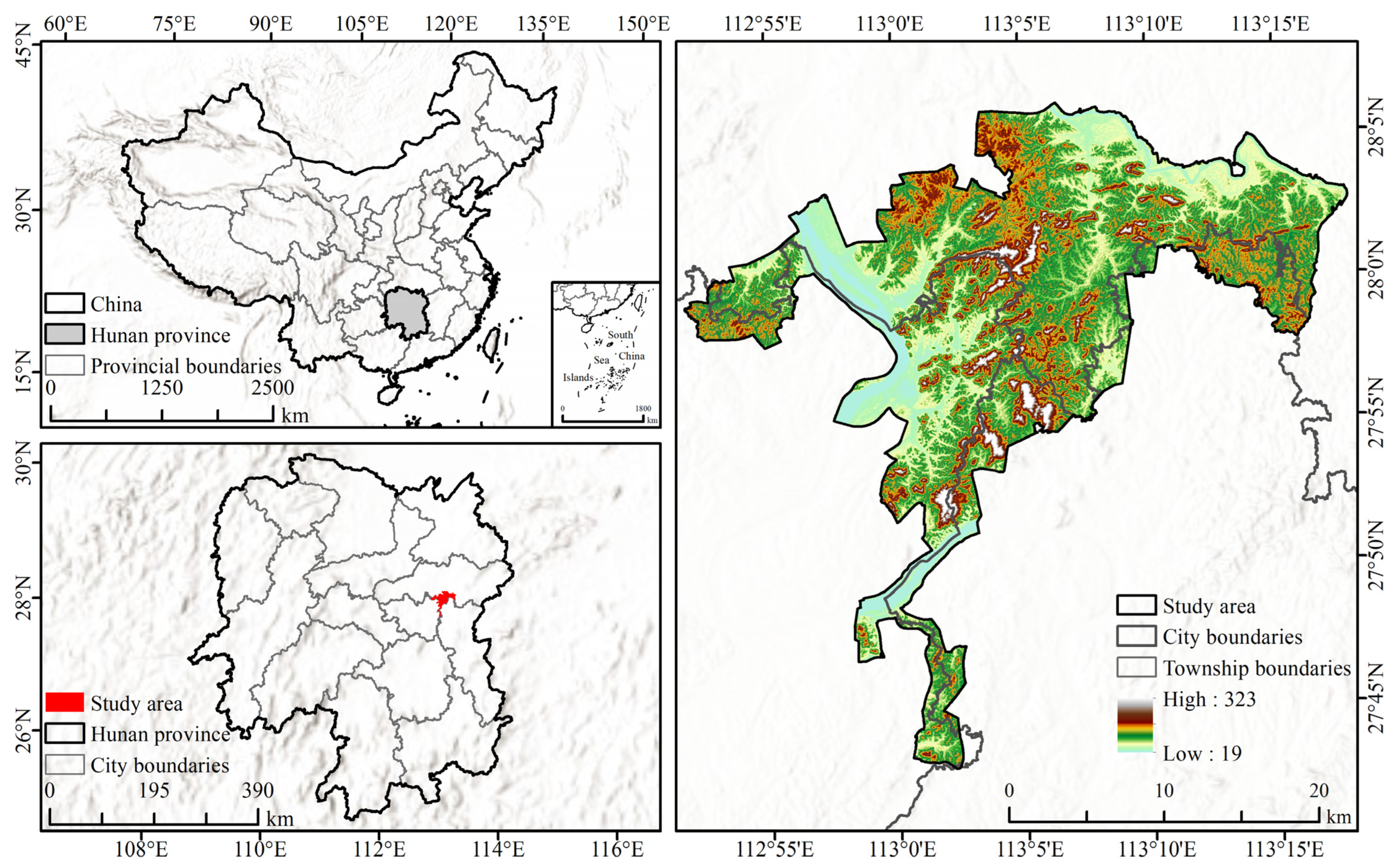
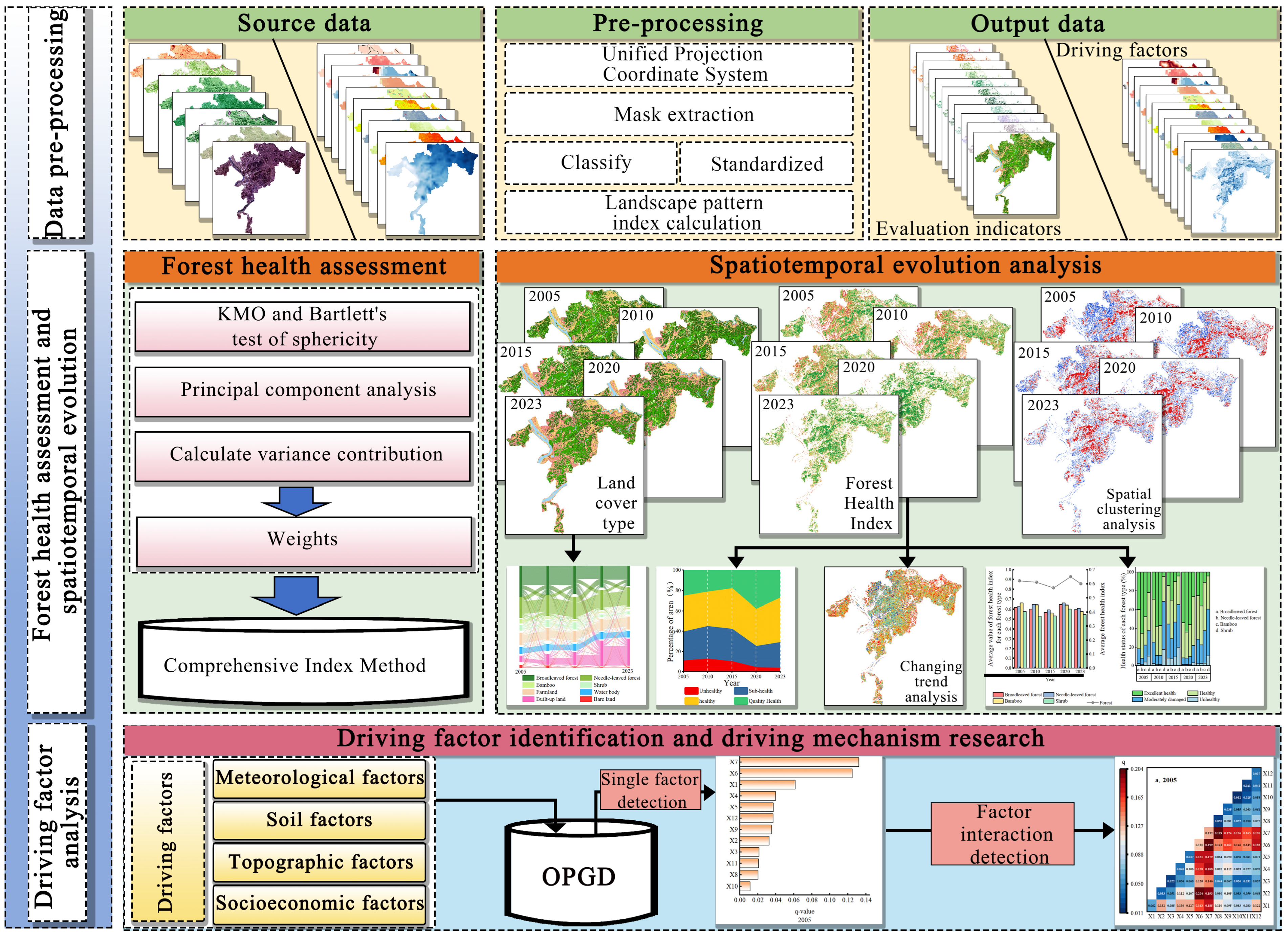
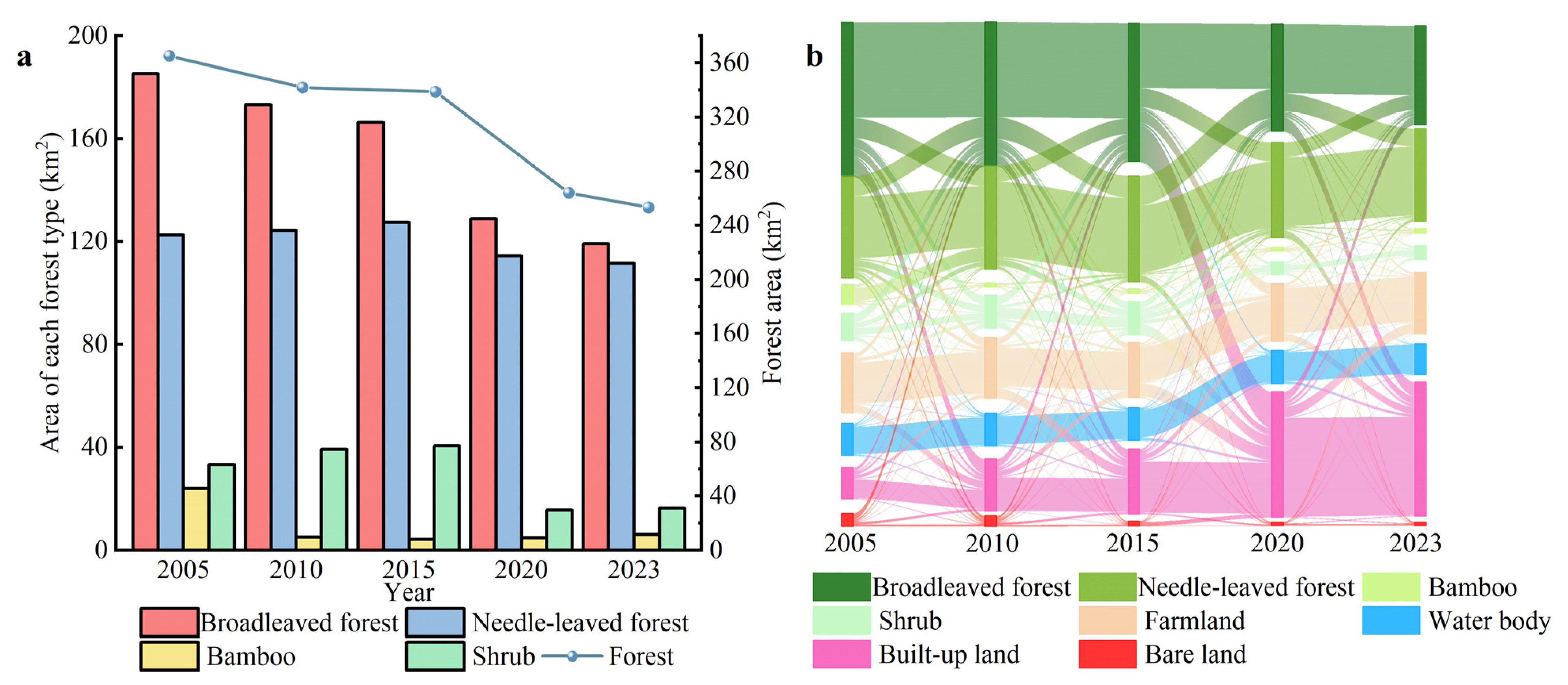
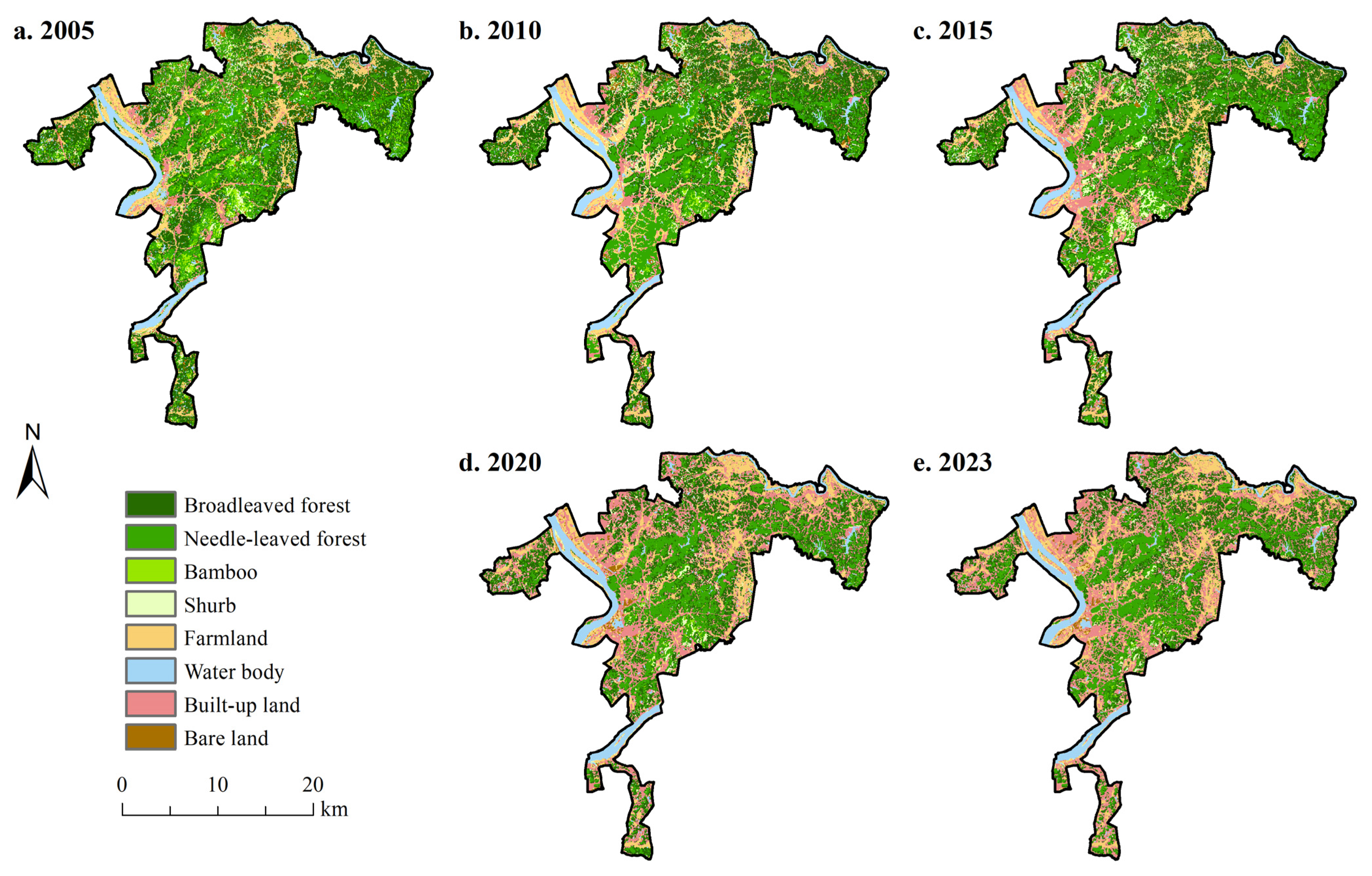
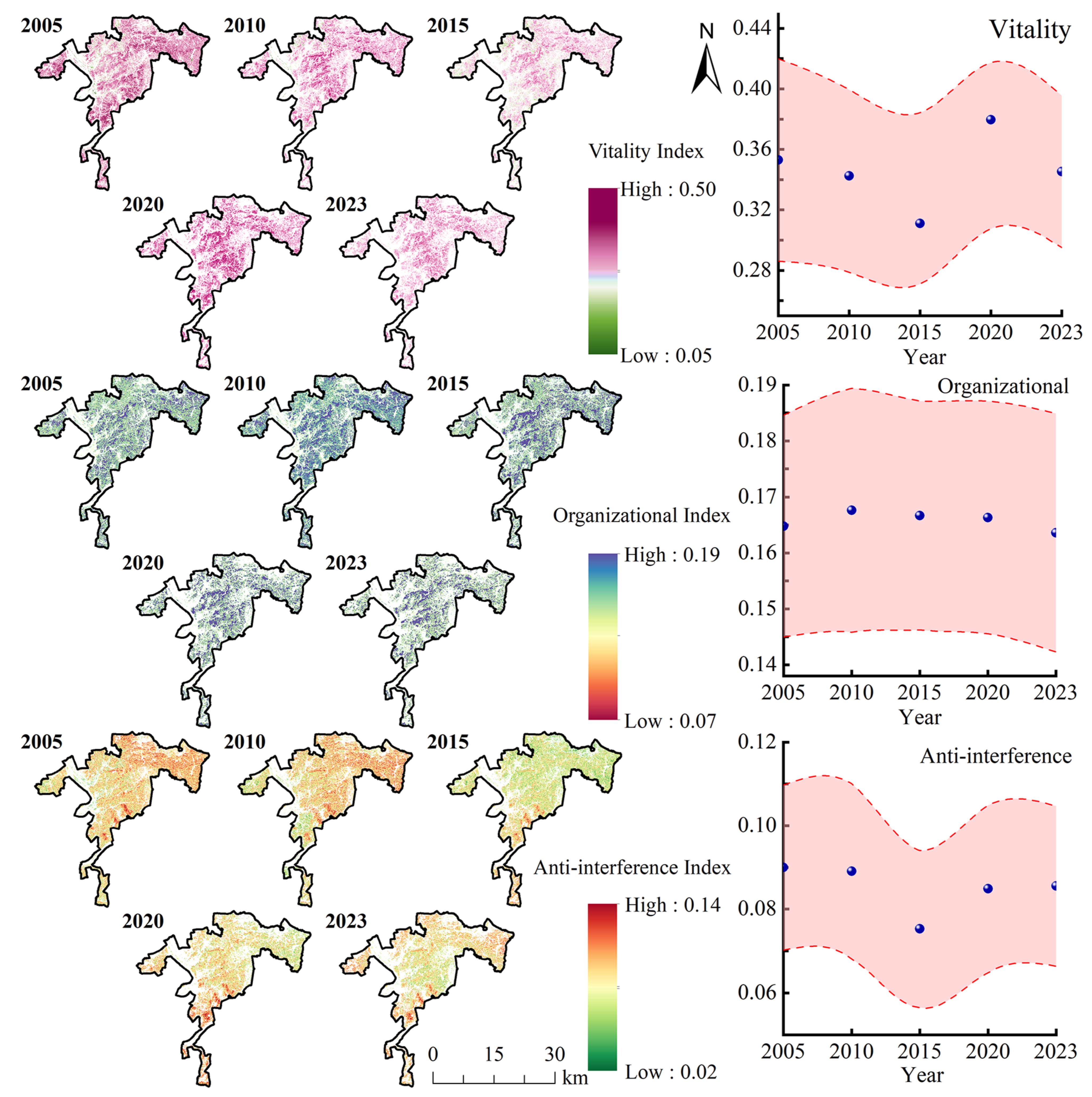
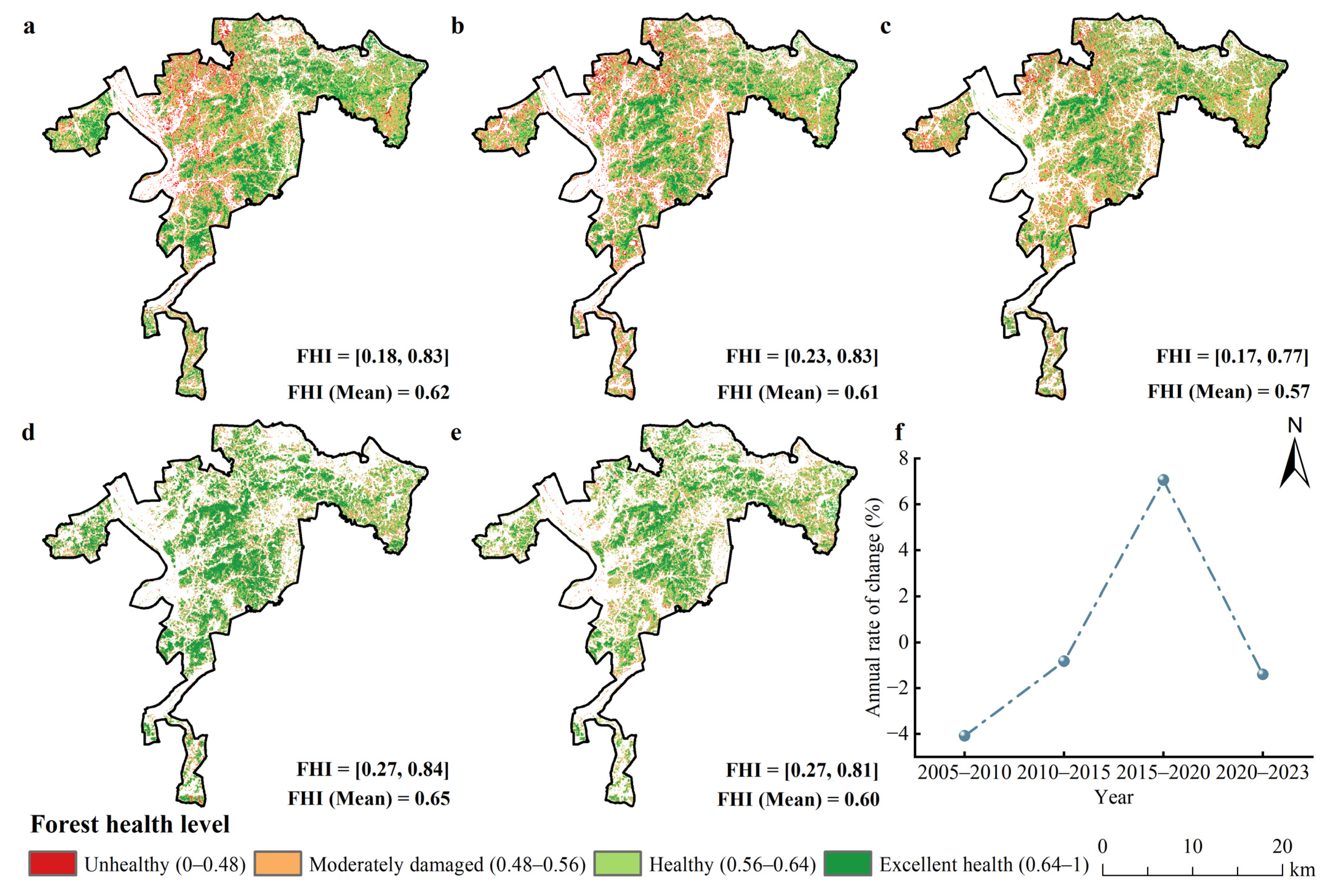
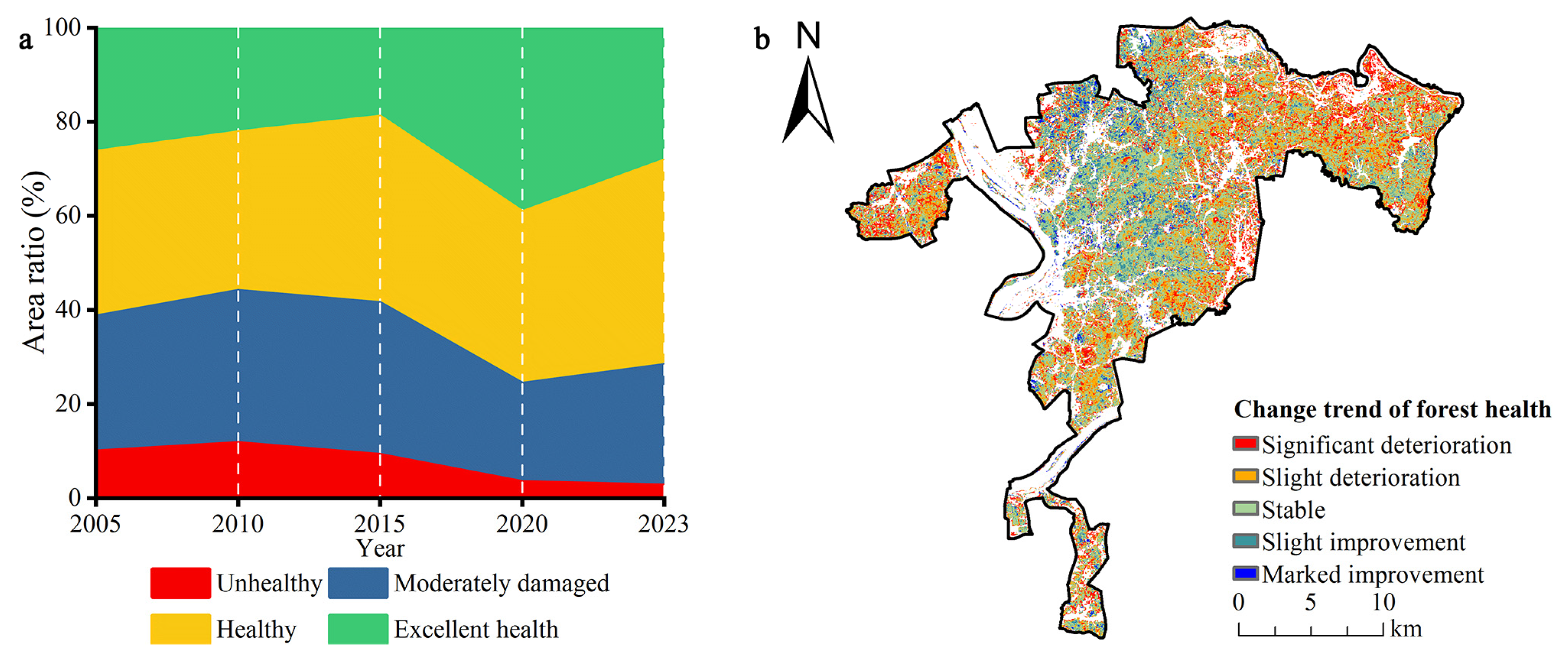

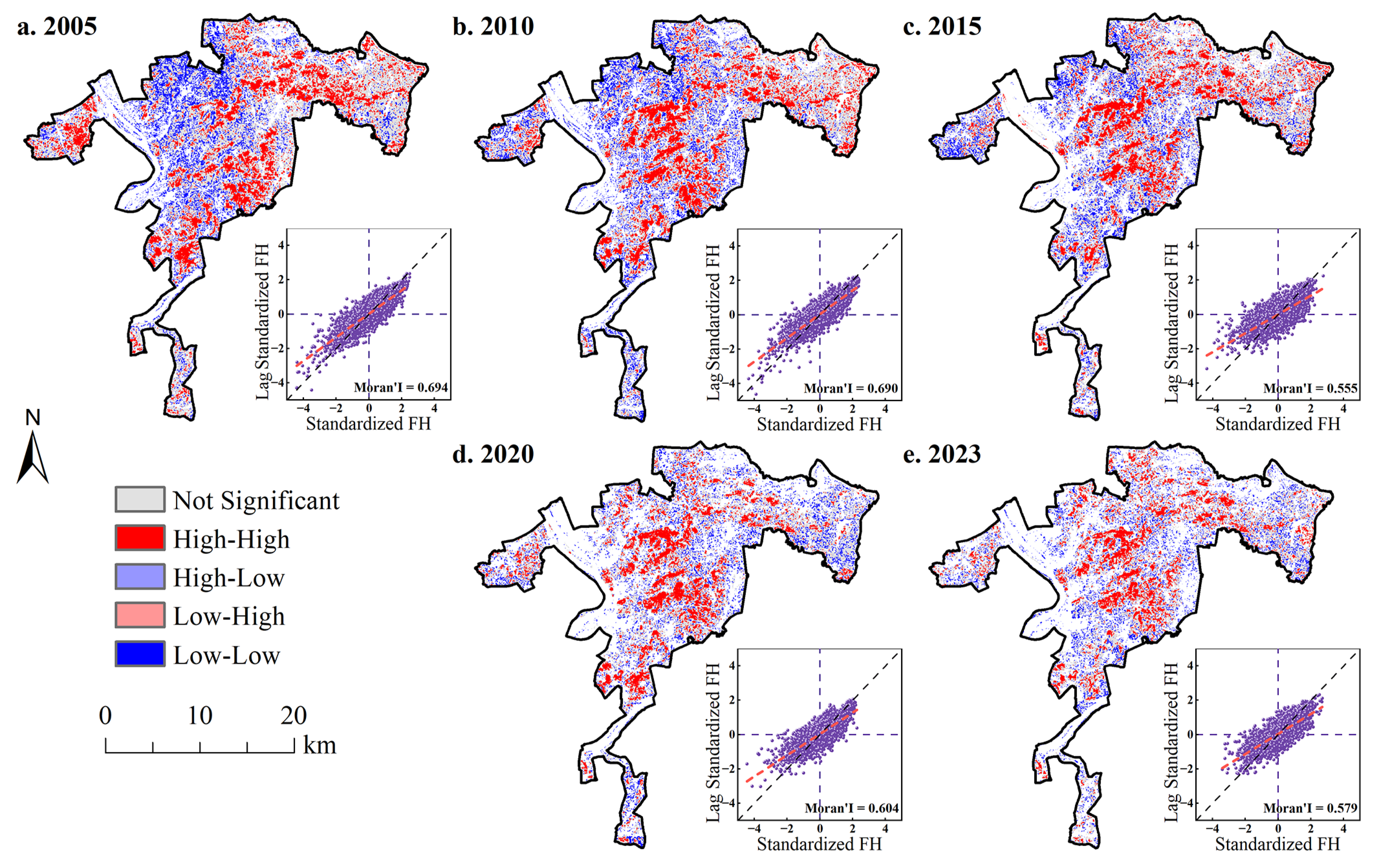

| Data Type | Name | Resolution (m) | Sources |
|---|---|---|---|
| Remote sensing | Landsat 5 TM | 30 | https://earthengine.google.com/ (accessed on 30 March 2025) |
| Landsat 8 OIL | 30 | ||
| EVI | 30 | ||
| NPP | 30 | http://gisrs.cn/ (accessed on 26 January 2025) | |
| FVC | 30 | https://earthengine.google.com/ (accessed on 30 March 2025) | |
| RDVI | 30 | ||
| LST annual max | 30 | ||
| Meteorological | Monthly average temperature | 30 | Fine Resolution Mapping of Mountain Environment |
| Monthly total precipitation | 30 | ||
| Topography | DEM | 30 | https://earthengine.google.com/ (accessed on 30 March 2025) |
| Slope | 30 | Derived from DEM | |
| Aspect | 30 | ||
| Socioeconomic | Population density | 1000 | https://landscan.ornl.gov/ (accessed on 5 March 2025) |
| Gross domestic product per capita | 1000 | http://gisrs.cn/ (accessed on 26 January 2025) | |
| Night lights | 1000 | Wu et al. (2021b) [15] | |
| Road data (railroads, expressways, national, provincial, and county roads) | 30 | https://www.webmap.cn/ (accessed on 5 March 2025) | |
| Auxiliary | The Ecological Green Heart Area 2023 comprehensive forest, grassland, and wetland monitoring data | / | The Forestry Department of Hunan Province |
| The Ecological Green Heart Area administrative boundary | / |
Disclaimer/Publisher’s Note: The statements, opinions and data contained in all publications are solely those of the individual author(s) and contributor(s) and not of MDPI and/or the editor(s). MDPI and/or the editor(s) disclaim responsibility for any injury to people or property resulting from any ideas, methods, instructions or products referred to in the content. |
© 2025 by the authors. Licensee MDPI, Basel, Switzerland. This article is an open access article distributed under the terms and conditions of the Creative Commons Attribution (CC BY) license (https://creativecommons.org/licenses/by/4.0/).
Share and Cite
Xu, Y.; She, J.; Chen, C.; Lei, J. Urban Forest Health Under Rapid Urbanization: Spatiotemporal Patterns and Driving Mechanisms from the Chang–Zhu–Tan Green Heart Area. Sustainability 2025, 17, 7268. https://doi.org/10.3390/su17167268
Xu Y, She J, Chen C, Lei J. Urban Forest Health Under Rapid Urbanization: Spatiotemporal Patterns and Driving Mechanisms from the Chang–Zhu–Tan Green Heart Area. Sustainability. 2025; 17(16):7268. https://doi.org/10.3390/su17167268
Chicago/Turabian StyleXu, Ye, Jiyun She, Caihong Chen, and Jiale Lei. 2025. "Urban Forest Health Under Rapid Urbanization: Spatiotemporal Patterns and Driving Mechanisms from the Chang–Zhu–Tan Green Heart Area" Sustainability 17, no. 16: 7268. https://doi.org/10.3390/su17167268
APA StyleXu, Y., She, J., Chen, C., & Lei, J. (2025). Urban Forest Health Under Rapid Urbanization: Spatiotemporal Patterns and Driving Mechanisms from the Chang–Zhu–Tan Green Heart Area. Sustainability, 17(16), 7268. https://doi.org/10.3390/su17167268






